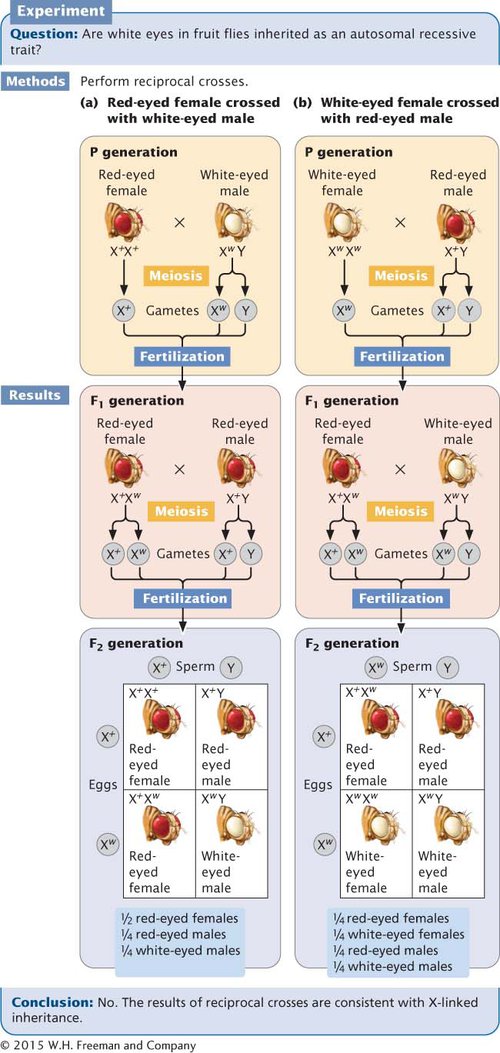X-Linked White Eyes in Drosophila
The first person to explain sex-linked inheritance was American biologist Thomas Hunt Morgan (Figure 4.7). Morgan began his career as an embryologist, but the discovery of Mendel’s principles inspired him to begin conducting genetic experiments, initially on mice and rats. In 1909, Morgan switched to Drosophila melanogaster. A year later, he discovered among the flies of his laboratory colony a single male that possessed white eyes, in stark contrast to the red eyes of normal fruit flies. This fly had a tremendous effect on Morgan’s career as a biologist and on the future of genetics.

Figure 4.7: Thomas Hunt Morgan’s work with Drosophila helped unravel many basic principles of genetics, including X-linked inheritance. (a) Morgan. (b) The Fly Room, where Morgan and his students conducted genetic research.
[Part a: AP/Wide World Photos. Part b: American Philosophical Society.]
To investigate the inheritance of the white-eyed trait in fruit flies, Morgan systematically carried out a series of genetic crosses. First, he crossed pure-breeding red-eyed females with his white-eyed male, producing F1 progeny that had red eyes (Figure 4.8a). Morgan’s results from this initial cross were consistent with Mendel’s principles: a cross between a homozygous dominant individual and a homozygous recessive individual produced heterozygous offspring exhibiting the dominant trait. These results suggested that white eyes are a simple recessive trait. When Morgan crossed the F1 flies with one another, however, he found that all the female F2 flies possessed red eyes, but that half the male F2 flies had red eyes and the other half had white eyes. This finding was clearly not the expected result for a simple recessive trait, which should appear in one-fourth of both male and female F2 offspring.

Figure 4.8: Morgan’s X-linked crosses for white eyes in fruit flies. (a) Original and F1 crosses. (b) Reciprocal crosses.
To explain this unexpected result, Morgan proposed that the locus affecting eye color is on the X chromosome (i.e., eye color is X linked). He recognized that the eye-color alleles are present only on the X chromosome; no homologous allele is present on the Y chromosome. Because the cells of females possess two X chromosomes, females can be homozygous or heterozygous for the eye-color alleles. The cells of males, on the other hand, possess only a single X chromosome and can carry only a single eye-color allele. Males, therefore, cannot be homozygous or heterozygous, but are said to be hemizygous for X-linked loci.
To verify his hypothesis that the white-eye trait is X linked, Morgan conducted additional crosses. He predicted that a cross between a white-eyed female and a red-eyed male would produce all red-eyed females and all white-eyed males (Figure 4.8b). When Morgan performed this cross, the results were exactly as predicted. Note that this cross is the reciprocal of the original cross and that the two reciprocal crosses produced different results in the F1 and F2 generations. Morgan also crossed the F1 heterozygous females with their white-eyed father, the red-eyed F2 females with white-eyed males, and white-eyed females with white-eyed males. In all these crosses, the results were consistent with Morgan’s conclusion that the white-eye trait is an X-linked characteristic. You can view the results of Morgan’s crosses in Animation 4.1.

